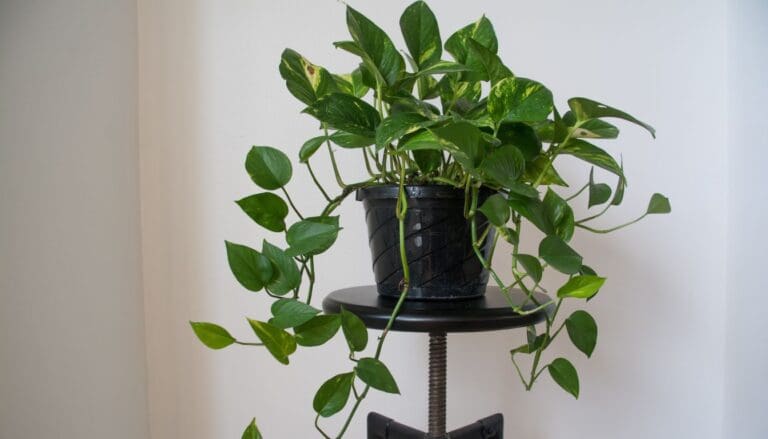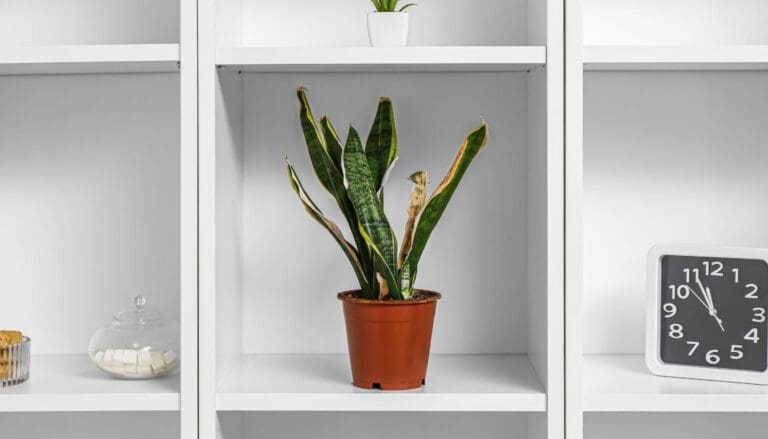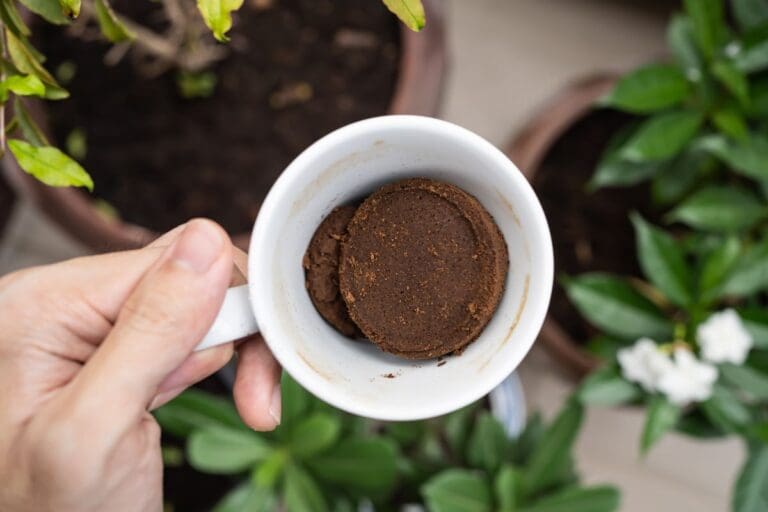Why Does My String Of Pearls Have White Spots? (Causes+What To Do)
The string of pearls plant has pearl-shaped green leaves that can tolerate extreme conditions such as droughts. However, it will develop problems if it is placed under unfavorable conditions for a prolonged period. White spots on the leaves are one of the problems you might notice.
Molds, Overwatering, and pest infestation are common problems that lead to white spots in the string of pearls. Other issues such as over-fertilization and low light can also lead to white spots in your string of pearls. Use neem oil to keep the pests away and avoid overwatering the plant.
Overwatering and low light conditions will make the plant weak and susceptible to diseases. Such an environment will attract pests and lead to fungal infections in the plant.
If you don’t provide proper attention and care to your string of pearls, the plant will suffer and develop problems and might give up on you if not treated on time.
Let’s understand the reasons behind white spots on your string of pearls plant.

Please note: Simplify Plants is reader-supported. Some links in the post are affiliate links and I get a commission from purchases made through links in the post.
What causes white spots in string of pearls?
Many reasons can lead to white spots in the string of pearls. Some causes can be:
- Overwatering
- Low light
- Poor drainage
- Over-fertilization
- Pests
- Molds
- Pruning
- Repotting
Let’s check out all the problems that lead to white spots on your string of pearls and how to fix them.
Pest infestation leads to white spots in the string of pearls

The string of pearls might get attacked by specific bugs or pests. The pests make your string of pearls weak by sucking on their sap. It can also lead to white molds on the plant and stop the plant’s growth.
You should keep an eye out for pests as they can kill the plant if not identified on time. Let’s learn about some pests that might attack the plant and how to deal with them.
Mealybugs on string of pearls
If you notice some white and cottony substance on your string of pearls, you should understand that these are mealybugs. Mealybugs are tiny pests that suck on the sap of your string of pearls.
As the mealybugs increase in number, they bring along further problems, including curling leaves, yellowing, and molds. You can use the following steps to eliminate these bugs from your plant.
- Separate your string of pearls from other plants and prune the infected and damaged areas.
- You can dip cotton in rubbing alcohol and dab the areas where you notice these insects.
- Create a solution by mixing 1 tsp of rubbing alcohol and 1 tsp of vegetable oil with 1 cup of water and spray it all over the plant. Do it after every few days.
- You can get an insecticidal pesticide that attacks the outer body of these pests and kill them.
Neem oil is an effective way of eliminating and preventing all pests. Mix 1 tsp of neem oil with 1 gallon of water and spray it on the plant every 7-14 days.
Spider mites on string of pearls
If you notice web-like structures on your string of pearls, then spider mites have infested the plant. Spider mites are commonly red, and they are relatives of spiders.
If the infestation is not treated, it will lead to yellow leaves and white molds on the plant.
Start with isolating the plant and pruning the infected parts. Wash the plant under running water to get rid of the pests.
Use organic miticides to eliminate the spider mites. Apply these weekly to ensure that the pests and their eggs are destroyed.
Mix neem oil with water and spray the mixture over the plant. Apply this every few days to get rid of the pests and their eggs.
You can dab rubbing alcohol on the spider mites to kill them.
Scale infection on string of pearls
If your string of pearls has scale infection, you can use horticulture oil to get rid of the infection. It is both effective and eco-friendly.
Apply the horticulture oil every few days to control the infection completely. Spray the oil directly on the scales and the excess oil will evaporate. Check the instructions and don’t overuse them.
The horticulture oil can damage the metabolism, thus controlling the scale infection.
Preventing pest attack in string of pearls
Besides getting rid of pests when they infest your plant, you can use preventive measures to keep them away.
Keep a check on your plant now and then to ensure that there is no pest infestation.
Avoid overwatering and over-fertilizing the plant as these can invite pests to the plant. Don’t keep the plant in low-light conditions for too long.
You should place the plant in an area with good airflow and spray neem oil on the plant to keep the pests away.
White mold in string of pearls
White molds can make your plant look ugly and over time the plant might die. Improper care and pest infestation are reasons behind this fungal disease.
You should try to fix the problem as soon as you become aware of it.
Preventing mold on string of pearls
White molds are primarily harmless, but they destroy the look of your plant. If molds are left without treatment, it will attract other problems.
Maintaining a good care routine will prevent this fungal disease on the plants. Provide sufficient light and adequate water. Ensure that the plant doesn’t sit on the excess water for too long.
Use well-draining soil and maintain good airflow around the plant. Keep checking the plant so that you don’t miss any signs.
White spots due to excess salt
If you water your string of pearls plant with tap water, it can have white spots due to the excess salt build-up.
Tap water contains minerals like fluoride and excess salt that remains after the water evaporates. As the salts start accumulating over time, they can limit the plant’s growth. These can lead to fungal or bacterial growth.
It is best to switch to filter water and use it for watering your string of pearls. If not, you can keep water in a bucket overnight and let excess salt sit at the bottom. And water the plant in the morning.
Preventing white spots in string of pearls
Take care of the following factors to prevent white spots on your string of pearls.
Watering

Rather than following a watering schedule blindly, you should check the soil before you water the string of pearls.
Avoid watering the plant if the soil is moist. Consider watering if the top two layers of the soil feel dry when you check with your finger or the moisture meter.
Overwatering is common in a string of pearls, leading to root rot and fungal infections. When you overwater the string of pearls, the leaves that store water burst and become white spots.
You need to water the plant thoroughly once the soil gets dry. Ensure that the drainage holes of the pot drain excess water within 2 minutes of watering.
Reduce watering during winter as that is the dormant period for the plant.
Also read: How Often Should You Water String Of Pearls?
Lighting

Lighting is essential to keep your string of pearls healthy and to help it grow. The string of pearls can tolerate low light, but the ideal condition is to provide bright indirect light.
The string of pearls doesn’t enjoy moist soil, which leads to white molds and pest infestations. If it doesn’t get enough light, the soil will remain wet for an extended period.
If the plant gets sufficient light, the soil will not remain moist, and you will be able to prevent mold or pests.
Place the plant in an area with six to eight hours of bright and indirect light every day. Use sheer curtains to filter direct sunlight coming from the windows.
You can place the plant under direct morning sunlight, but it can’t tolerate the harsh afternoon sunlight. So, a south-facing window would be the ideal option for your string of pearls.
Keep the plant away from cold drafts during the winter. You can place it away from the window or close the window.
Also read: How Much Light Does String Of Pearls Need?
Fertilizing

Fertilizing the string of pearls is essential, but you should remember that these plants are light feeders and don’t need much fertilizer. The fertilizer provides adequate nutrition to the plant and boosts its growth.
If you over-fertilize the string of pearls, it hampers the soil quality and makes the plant vulnerable to pests, fungal and bacterial growth.
Fertilize the string of pearls using a dilute well-balanced liquid fertilizer once or twice during the growing season.
Avoid fertilizing during the winter season as the plant doesn’t grow during that period, and the fertilizers will burn the roots and make the plant weak.
Also read: Should You Fertilize String Of Pearls?
Pruning
The string of pearls can tolerate extreme conditions, but lack of care can cause yellow or brown leaves, white spots, curled leaves, etc.
If your plant has damaged leaves, you should prune them and help the plant recover fast so that pest infestation or fungal growth is not encouraged.
Always use sharp and sterilized scissors to prune the plant. Wear gloves to avoid skin irritation due to the plant’s sap.
Prune after regular intervals to ensure that there are no damaged parts and the plant is healthy and growing.
Repotting

Repotting your string of pearls very often can be highly stressful for the plant. Frequent repotting can make the roots weak.
The string of pearls has a shallow root system, so it doesn’t need repotting often. You should consider repotting if there is a root rot or if the plant is root-bound.
Avoid repotting the string of pearls in winter as that is the dormant period for the plant, and repotting will shock the plant.
If you are repotting, choose a pot that is one size bigger and spray fungicide in the soil to keep the infections away.
Also read: Can String Of Pearls Be Root Bound? How to repot?
Tips to keep string of pearls plant thriving
- Use organic miticide or fungicide to prevent pest infestation and fungal infections.
- Check the soil before watering the plant, so you don’t overwater it.
- Provide sufficient indirect light to the plant for at least six to eight hours regularly.
- Repot the plant if the plant is root-bound or is suffering from root rot.
- Avoid misting the plant as it makes the leaves moist, and the string of pearls doesn’t enjoy that.
Ref: Wikipedia, Missouri Botanical Garden, University of Wisconsin.
Recommended Garden Supplies
| Product Image | Our Recommended Gardening Supplies | Check Offers! |
|---|---|---|
Top Top
Top
Top
Top
Top
Top
Top
Top | rePotme Houseplant and Tropical Classic Potting Soil Mix | Check Offer On Amazon |
 Top
Top
Top
Top
Top
Top
Top
Top | Espoma Organic Indoor Plant Food | Check Offer On Amazon |
 Top
Top
Top
Top
Top
Top
Top
Top | GooingTop LED Grow Light 6000K Full Spectrum Clip Plant Growing Lamp | Check Offer On Amazon |
 Top
Top
Top
Top
Top
Top
Top
Top | Soil Moisture Meter | Check Offer On Amazon |
 Top
Top
Top
Top
Top
Top
Top
Top | Govee Hygrometer Thermometer, Bluetooth Enabled! | Check Offer On Amazon |
 Top
Top | LEVOIT Humidifiers for Large Room(Best For Plants) | Check Offer On Amazon |
 Top
Top
Top
Top
Top
Top
Top
Top | Upgraded DIY Automatic Drip Irrigation Kit, 15 Potted Houseplants Support | Check Offer On Amazon |
 Top
Top
Top
Top
Top
Top
Top
Top | Stainless Steel Heavy Duty Gardening Tool Set | Check Offer On Amazon |
 Top
Top
Top
Top
Top
Top
Top
Top | Bonide Insecticidal Soap | Check Offer On Amazon |
 Top
Top
Top
Top
Top
Top
Top
Top | Bonide 32 oz Spray Neem Oil for Organic Gardening | Check Offer On Amazon |
 Top
Top
Top
Top
Top
Top
Top
Top | Garden Safe Fungicide | Check Offer On Amazon |








Couldn’t find u on FB. Have string of pearls with white spots. Need some advice on how to fix problem.